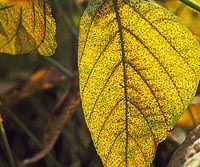Changes for Soybean Rust Watch
Changes for Soybean Rust Watch

Lessons learned in 2005 are resulting in some changes to how researchers plan to watch for the potential arrival of Asian soybean rust in Kentucky during 2006.
“Last year most of our activity was done in the field by the scouts,” said Don Hershman, University of Kentucky College of Agriculture plant pathologist. “This year, more of the work will take place in the laboratory.
“Scientists in the Deep South found that it is nearly impossible to find low levels of soybean rust in the lower canopy by field scouting,” he said. “I can’t do it, and by the time you begin to see rust, it is too late to get complete control with a fungicide. What they found is that to detect the levels to make effective fungicide treatments, requires incubation followed by microscopic observation.”
Last year, there was an extensive network of sentinel plots across the United States and Canada. These plots were planted early using varying soybean maturity dates, then were scouted extensively in an effort to watch for the disease. There were 37 soybean plots in Kentucky along with several kudzu plots.
The number of plots will be reduced this year because it was determined a better job of gathering data could be done with fewer plots. U.S. Department of Agriculture’s Risk Management Agency and soybean checkoff money are being used to fund the plots. Hershman is the southern coordinator for the National Sentinel Network.
There will be 20 plots in Kentucky, each containing an early and late variety to avoid maturing before the main soybean production season is in full swing. Greater reliance on
microscopic observation in the laboratory and DNA and antibody testing, when necessary, will be done every other week until plants flower and weekly once flowering begins. This is the efficient way to do it and is sustainable, Hershman noted.
One of reasons for having sentinel plots is to detect soybean rust before it gets into commercial fields. This gives producers time to treat their fields to stave off the disease. Hershman said 2005 research has shown that producers will have slightly more time to spray their crops and keep them from being severely damaged than first thought. There is a three-week to four-week period when the disease is getting established in the canopy before it enters the “explosive” stage that causes extensive damage.
“The point is you have more than one day to get effective control,” he said.
Kentucky will continue to participate in a separate spore trapping network, but Hershman said it is important to understand that the system currently can only determine if rust-like spores have been detected, but not whether it is the soybean rust fungus. Several spores were detected in Kentucky but actual soybean rust was found only in one location in Kentucky - on kudzu in Caldwell County in November.
“What this tells me is that there is no relationship between these finds and what we can expect to see in the soybean crop,” he said. “Even when they found soybean rust in southern areas, it was 35 days to 75 days before it showed up in any fields. So my recommendation is to ignore this information this year. I’m not saying that at some point this won’t be valuable information, and I’m going to continue to do the work. Two, three, 10 years from now, we may have some very specific information as we learn more about the disease. I think for now, the chances of being able to tell you what any spore trap information means is next to zero. Certainly, do not use it for making any fungicide treatments.”
The prognosis for soybean rust in 2006 is uncertain.
One big difference is, unlike 2004-2005 when very little of the disease was available for overwintering, this winter soybean rust is still being found on kudzu in 10 counties in Florida, one in Alabama and one in Georgia, so there is a greater chance of successfully overwintering. Weather conditions this spring and summer in the south will also play a role as dry conditions are not conducive to disease spread.
Farmers need to find reliable sources of information to base spray decisions, Hershman said. Some key sources can be found through the rust hotline, (800) 321-6771, sponsored by the Kentucky Soybean Promotion Board and through the USDA Rust Web site.
“I don’t think soybean rust will be a widespread problem this year. If anything I believe it will be piecemeal and it will come in late,” Hershman said. “Time will tell.”
